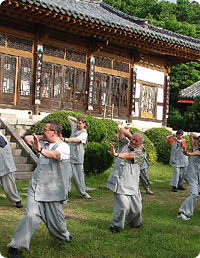SPECIAL INTEREST
Temlpe stay 5 days
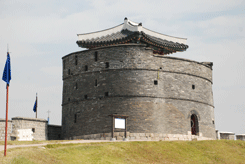
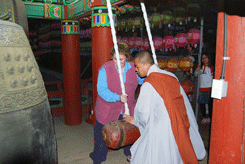
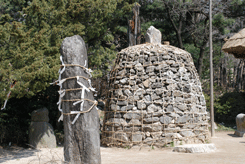
Tour Highlights
- Gyeongbokgung Palace
- National Folk Museum of Korea
- Jogyesa Temple
- Insadong
- Namdaemun Market
- Chojijin Fortress
- Temple Stay
- Ganghwa History Museum
- Ganghwa Dolmen
- Ginseng Market
- Gimpo Marine Park
- Hwaseong Fortress
- Korean Folk Village
The temple stay is subject to operate with minimum 10 people
| Days | Visits and Activities | Distance |
| Day 1 | Arrive Seoul | 60km |
| Day 2 | Seoul Ganghwado | 70km |
| Day 3 | Ganghwado - Suwon | 90km |
| Day 4 | Suwon - Yongin - Seoul | 60km |
| Day 5 | Departure | 60km |
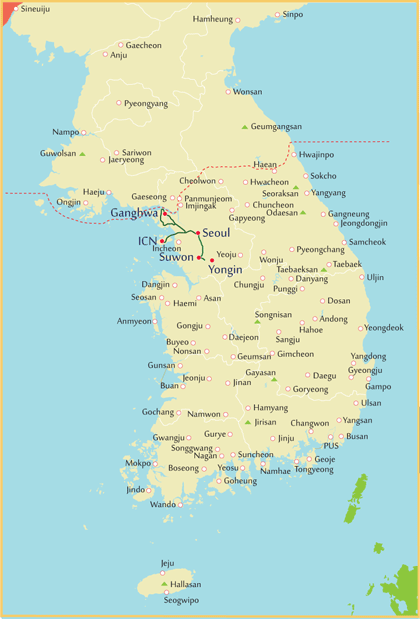 Day 1 Arrive Seoul (- - -) 60km
Day 1 Arrive Seoul (- - -) 60km
Touching down at Incheon International Airport places you in the heart of Korea. After you clear Passport and Customs control, you will be welcomed by the tour guide and then transferred to your hotel.
Day 2 Seoul - Ganghwado
(B D) 70km
Your exploration this morning begins with a driving tour of Seoul, featuring sites such as Seoul Plaza, City Hall, Cheonggye Square and pedestrian-friendly Gwanghwamun Plaza that is hemmed in on both sides by rushing traffic and office buildings. The plaza is lined on each side with 365m long streamlets, two centimeters deep and one meter across, the stone bed of the plaza's east side waterway engraved with important events in chronological order from 1392 to 2008.
Standing high on a stone pillar is a statue of Yi Sunsin who had engaged in twenty-three naval battles and emerged victorious in all of them during the Hideyoshi invasion (1592-1598). King Sejong who propagated the Korean alphabet in the 15th century is also honored with prominent statue. On August 16, 2014, Pope Francis celebrated Mass in this plaza to beatify 124 Korean martyrs. Near the southwest corner of the plaza is Korea's Kilometer Zero, marking the distances to 64 cities around the world, including Seoul's antipode, Montevideo, Uruguay, 19,606km.
Step back in time to when life was gracefully slow and discover Gyeongbokgung Palace, a particularly charming spot that represents a colorful and turbulent side of the capital's 500-year history. Depending on timing, you may witness the Royal Guard Changing Ceremony featuring parade, password verification, duty shift and patrolling the gate. Accompanied by a court band with its colorful costumes and royal flags, the ceremony is performed daily basis at 10:00 and 14:00 except Tuesdays, although it is cancelled in case of rain or extremely hot or cold weather.
Up from the gates is a spacious stone-paved courtyard that is fully enclosed by wooden cloisters, and at the center of which runs three footpaths through two rows of rank stones, indicating the positions of the officials with the highest rank being closer to the hall.
Standing majestically on top of a two-tiered stone platform that is lined with detailed balustrades is Geunjeongjeon Hall, where the king formally granted audiences to his officials, gave declarations of national importance, presided over large official functions, and greeted foreign envoys and ambassadors. Check out the royal throne and a large painting, depicting sun, moon, five peaks, streams and pine trees, which was the crucial signifier of the king. And up in the center of the ceiling, the bright golden dragons in bold relief indicate the presence of the king.
At the back of the throne hall is a group of court offices. Displayed in front of the King's official quarters is sundial, conceived in order to catch the shadow of the sun, which tells time and 24 periods of seasonal change from the winter solstice to the summer solstice.
Sitting on the island in the rectangular lake is Gyeonghoeru. Supported by 48 square and cylindrical massive stone pillars representing the idea of Yin and Yang, this magnificent pavilion was used for many purposes ranging from receptions to national examinations.
Gangnyeongjeon is the king's sleeping and living quarters while Gyotaejeon is the queen's domain containing a number of halls. The noted feature of these main buildings is an absence of a top roof ridge.
Amisan Garden, landscaped with four hexagonal chimneys in orange bricks, is seldom noticed by the hurried visitors. Jagyeongjeon is the queen dowager's residence. Although less colorful, it is worth noting the wall, adorned with floral designs and the chimneys with ten longevity symbols.
Hyangwonjeong features a small pond with a manmade islet that supports a beautiful two-story pavilion. Behind this serene garden is Geoncheonggung, where the king and queen could relax in peace and quiet. It was here that the first electric lights in the country were installed in 1887 after 8 years of Thomas Edison's invention and a tragic chapter in Korea's history was recorded when empress Myeongseong was assassinated by the sword-bearing Japanese assassins in the early morning of 8 October 1895, allegedly under orders from Miura Goro.
Your visit to the National Folk Museum of Korea will familiarize you with wealthy culture of this friendly and picturesque nation. It is an excellent facility to illustrate the history of traditional life of the Korean people from the prehistoric age to the Joseon dynasty. The permanent exhibition features life and work, costumes and ornaments, handicrafts and technology, educations, living quarters, dietary life, oriental medicine, performing arts and games, beliefs and rituals, and
socio cultural life.
Drive past Korea's first post office.
On the evening of Dec. 4, 1884, a banquet was held here to celebrate the successful inauguration of Korea’s postal system. Ironically, it was this celebration that helped doom Korea’s postal system as well as other early modernizations. The ill-fated “Gapsin” Coup lasted a mere three days but its toll was heavy. It wasn’t until 1895 that Korea again established a domestic postal system. This was followed by an international mail service in 1900.
Squeeze in a stop at Jogyesa, the head temple of Jogyejong the principal sect of Korean Buddhism, emphasizing the Zen orthodox, meditation tradition and the purity of monastic celibacy. The temple does not give off the solemn and traditional air of the other temples located deep in the mountains, but when you enter the temple the frenzy of the city start disappearing. The Main Worship Hall holds triad Buddhas, Sakyamuni, Amitabha and Bhaisajyaraja. The figure in the center is Sakyamuni Buddha who has overcome greed, hatred and delusion. While here it is worth noting the 500 year old lacebark pine and 400 year old locust tree that still grace the property.
Insadong, at one time the center of traditional Korean art and antiques, features a mixture of historical and modern atmosphere representing the cultural glimpse of the nation. Clustered along the main street and alleys are lined with street vendors, wooden tea houses, restaurants and numerous galleries and shops dealing in antiques, oriental art supplies, and modern Korean art of all types and styles. Soak in the paintings, upscale artworks, antiques and potteries while you can. Get lucky and you just might meet the artist themselves. It can be plenty of fun walking on the main street, but you venture into the hidden alleys that do spring some unexpected surprises. While here, you may want to buy some souvenirs or simply wander and browse at leisure admiring cultural ambience.
Drive past Cheonggyecheon Stream. After the Korean War (1950-1953), more people migrated into Seoul to make their living and settled down along the stream in shabby makeshift houses. The accompanying trash and waste, and deteriorating conditions resulted in an eyesore for the city. The stream was covered with layers of concrete in the mid 1950s and roadway until the massive urban renewal project freed it in 2005. Today, a 5.8km creek tumbles gently through downtown Seoul, providing a much needed source of peace and relaxation for the citizens of this fast-paced city. You may have a chance to view the sculpture standing tall at the head of the stream on a small plaza. Created by Dutch artist Coosje Van Bruggen and Swedish artist Claes Oldenburg, a shell rising upward like pagoda symbolizes new life.
You will tour the centuries-old Namdaemun Market brimming with well over 11,000 shops selling anything you can imagine. One of the most colorful aspects of the market is an endless sprawl of street-vendor stalls that setup in the alleys and walkways between the buildings. The market is seriously crowded, so be prepared to get bumped around. A fantastic place to haggle over the price to get the best deal on something you want or simply admire the vibrancy of this massive market.
At the western entrance of the market in the middle of a traffic circle stands Sungnyemun. It is a formidable and iconic construct that served as the southern gate of the wall that surrounded Seoul during the period of the Joseon Dynasty.
With time to city exploration, travel to Ganghwado, a fascinating island that is often called a microcosm of Korean history. But, due to its strategic location, Ganghwado has historically been one of the first targets of many foreign attacks particularly in the late 19th century when Korea unsuccessfully sought to maintain its status as a "Hermit Kingdom".
Chojijin speaks to the battles against foreign powers. In 1866 the Korean court came to blows with the French campaign led by Admiral Pierre-Gustave Roze in retaliation for the earlier execution by Korea's Joseon dynasty of French Catholic priests proselytizing in Korea. In 1871 the United States expedition, the Sinmiyangyo, was the first American military action in Korea to avenge the General Sherman incident near Pyeongyang. The expedition consisted of about 650 men, over 500 sailors and 100 marines, as well as five warships. On board the Colorado was Rear Admiral John Rodgers, also Frederick F. Low, the United States Ambassador to China. And in 1875 the collision with the Japanese ship Unyomaru.
Today, you will experience a traditional monastic life at Jeondeungsa, an active Buddhist temple dating back to 381 providing a glimpse into Buddhist culture. The temple came into prominence during the late Goryeo period (918-1392) when King Gojong commissioned the famous Tripitaka Koreana wood blocks to be carved there which are now preserved in Haeinsa temple. The main worship hall is dedicated to Sakyamuni Buddha. The Buddha is flanked on the left by Manjusri, the Bodhisattva of Perfect Wisdom, and on the right by Samantabhadra, the Bodhisattva of Perfect Compassionate Action. As you approach the hall, look carefully way up in the eaves at the corners of the roof, and there you can just see tiny human figures, one at each corner. One version says that the forsaken carpenter carved his two-timing girl up in the rafters, eternally bearing the burden of her deceitfulness. You will see a dharma bell dating back to 1097, the only Chinese bell designated a Korean treasure.
There are many temples in Korea, but the opportunity to observe and experience the ascetic Buddhist life in a temple does not come easily to outsider visitors. Some of the temples in Korea open their doors to foreign visitors for a short sojourn to give visitors the opportunity to see how monks practice their daily discipline from early morning prayers to evening rites. The temples are places where Buddha dwells and where the disciples of Buddha, or monks, practice asceticism. It is also a place where believers learn Buddhist teachings and put them into practice. Visitors will get to study and experience the Korean tradition and culture, all at the same time enjoying the nature.
Temple stay program may slighly vary due to season and conditions of the individual temple situation but it basically includes Evening Ceremony-Yebu during which you will learn how the monks pay respect to the Buddha as you listen to their rhythmic chanting. You will experience silent introspective meditation interspersed by gentle advice from the monks, and enjoy a traditional Buddhist prayer bead making. Beads are used to count to 108, and during the temple stay bowing ceremony led by monk, you get to string your own beads.
One by one, bow by bow. Other programs may include Tea Ceremony, Rubbings, Buddhist Martial Arts, and Lotus Lantern Making, etc.
Upon arrival at the temple and having your rooms assigned,
you will have a temple stay orientation session during which desirable appearance, behavior in the temple and general manners in the Buddha Hall are briefed, and Baru Gongyang Practice followed by
temple tour. Then you will experience temple meal perhaps first time in your life. The food doesn't have spices and is neither hot nor salty. The temple way of eating is available to laymen though, you will simply have your dinner in the temple dining hall. It is another mysterious experience for the commoners to try.
Following the dinner, Four Buddhist Instrument
Ceremony is performed. The bell, which almost all Korean temples are equipped with, is one of the four Dharma instruments together with Dharma drum, wooden fish, and cloud-shaped gong. Hearing it reverberating through the universe, you will reflect upon the profound symbolism of the instruments. It is a great vow to save, or enlighten the creatures in the universe including those on land, in the sea, in the air and in hell. After this ceremony, you will participate Evening Ceremony, Zen meditation and experience Prayer Bead Making.
All lights are turned off at 21:00. Apart from the moan of the wind, a quiet stillness prevails. The warm Ondol floors (heated from below) of the temple are clean and large enough to accommodate a small group of visitors. Rooms are sparsely furnished with mattress, quilt and pillow. It is advisable to bring your towel. However, the slight inconvenience is more than compensated by the tranquil and introspective atmosphere of the temple.
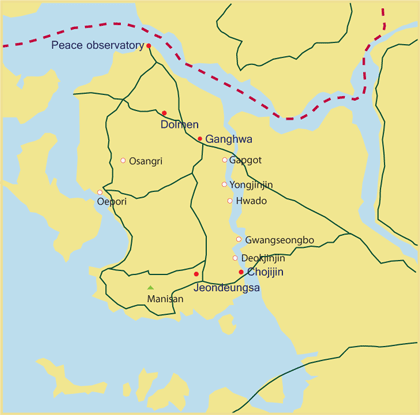 Day 3 Ganghwado - Suwon (B) 90km
Day 3 Ganghwado - Suwon (B) 90km
The day in the temple begins at 04:00 when the sound of the moktak awakens the residents. Every monk and people in the temple will gather at the Main Buddha Hall and perform Pre-dawn Ceremony. This magnificent Ceremony will clear all dust from your minds and all stray thoughts from your heads. During the ceremony, you will offer 108 prostrations to show respect for Buddha as well as align your body in a proper way to have a release and cleanse your mind of earthly attachments, passions and delusion that disturb and pollute your body and mind.
You will experience Baru Gongyang, a unique and special dietary arrangement of Buddhism. It is a monastic ritual of eating that requires complete silence and no wasting of food. After breakfast, Walking Meditation, Tea Time with monk, and Ulyeok or Communal Work complete your temple program.
Normally Ulyeok agenda includes farming or upkeep. However, if there is no particular agenda, one normally does ordinary sweeping of court yards or cleaning the buildings. This is not just physical work, but should be seen as another way of practicing, developing patience and discipline. While not as intensive as Zen meditation, the tedium and mundanity of basic work provides a strong foundation for the monks practice. Also, after meditation, sutras reading, and worship, monks find Ulyeok relaxing. Washing gowns you wore during the stay, sweeping autumn leaves from the courtyard or snow from the pathways provides an opportunity to relate quietly with the nature, and with each other in the community of work. With all these benefits, you should join Ulyeok with pleasure. It is a good way to express gratitude to your hosts. Practitioners also find themselves refreshed through Ulyeok.
Visit Ganghwa History Museum displaying historical records of the entire spectrum of Korean existence, from the mythical foundation of Korea to the opening port to the outside World marked by Ganghwado Treaty signed in February 1876. Nearby Ganghwa Dolmen, one of the most famous dolmens in Korea measuring 50-ton capstone, 7.1 meters long, 5.5 meters wide and 1 meter thick, rests on two sturdy supporting prop stones. This prehistoric dolmen including many others in Gochang and Hwasun has been registered by UNESCO as a World Heritage for their archaeological value.
There's a time to visit Gimpo Marine Park for an introduction of a unique Landing Ship Tank. Retired in 2006 after 62 years of service, the LST is on display along with LCVP (landing craft, vehicle and personnel) that was used in Incheon landing operation in 1950, S-2 Stracker maritime patrol aircraft and an amphibious vehicle. This LST participated in landing operations in France and Okinawa as well as the Vietnamese War from February 1966 to December 1972, supporting the rearguard operations of South Korean troops. Nearby Daemyeong Port is a local seafood outlet that exudes the typical atmosphere and charm of a small fishing village.
Day 4 Suwon - Yongin - Seoul (B) 60km
Explore UNESCO World Heritage site of Hwaseong Fortress from the 18th century. Though it is relatively small in scale, it is well acknowledged as the best structure of its kind ever built in Korea. A 5.74km-long fortress enclosing both flatland and hilly terrain is parapeted with crenels and merlons and highlighted by four main gates and well over 50 structures including temporary palace where the king sought refuge during war and found rest during times of peace. A walk through the whole fortress could take several hours but it is well worth making a short walking tour to enjoy the splendor of the fortress, including the Korea's largest Janganmun Gate.
You will then experience the heritage of the Korean people and soak up the local culture. A village entrance is marked by an eye-catching stone tower topped by a symbolic stone serving as fertility and protective totem, where people write a wish on the paper and tie to the ropes. Korean Folk Village is a functioning community displaying the diversity of Korean lifestyle and culture of several centuries ago. On entering the village, you are greeted by goofy looking group of wooden Jangseung signifying village boundary and preventing bad luck.
The village holds a wide assortment of residential structures from the straw-thatched cottages of commoners to the 99-room mansions of the noble class as well as governor's office. There are many workshops where the real artisans and craftsmen dressed in traditional costumes ply their trades, demonstrating centuries-old craftsmanship in the art of pottery, pyrography, bamboo craft, Korean paper, brassware, and many more. While strolling past the houses and workshops one by one, you will get the feeling of walking through time in an ancient village.
Depending on timing, enjoy farmer's music and dance, which has been the beloved form of entertainment of Korean people, bearing testimony to the gregarious character of Korean fun-making and festivity. Jultagi or acrobatics on a tightrope is something you cannot miss. The rope walker executes a variety of acrobatic feats on the rope, along with jokes, mimicry, or songs, while a clown engages the tightrope walker in joking banter, and a team of musicians plays music to accompany the entertainment.
You will experience some of long-observed seasonal customs, beliefs, folk games or plays that have been comprehensively reflected the daily life of the Korean people. A traditional wedding ceremony is also performed on a daily basis, although it may no longer be explicitly followed.
A traditional marketplace offers the exotic flavors of Korean cuisine from different regions. Shops stock a variety of handicrafts and souvenirs, many of which were made on the premises. With all these features combined, the tour offers a fascinating insight into the unique Korean lifestyle of the days gone by.
Day 5 Departure (B) 60km
After this wonderful trip exploring Korea and with time to reflect on your surprise in your experience, you will return to the airport in time for your flight. By boarding, you are already high above Incheon heading for home.





